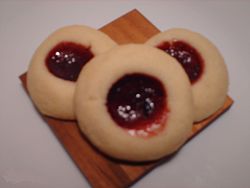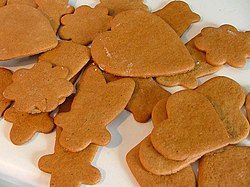Sju sorters kakor

Sju sorters kakor (Norwegian: syv slags kaker), "seven kinds of cookies", is a Swedish and Norwegian tradition where hosts typically prepare seven different kinds of cookies for their guests. While the specific type of cookie varies from household to household, the number of types is consistently seven, as less than seven would indicate an insufficient host, while over seven would indicate a pretentious host.[1] While the tradition started in Sweden, it has since spread to Norwegian and Scandinavian-American households.
History[edit]


In 1823, Sweden lifted its ban on coffee consumption, leading to more coffee being drunk around the country.[2] This led to an increase in 'kaffehus' – small cafés that would typically serve coffee and småkakor (little cookies). As cafés became more popular and fika became more common, competition for the highest quality cookies became rampant, and hosts were pressured to create varieties of different cookies for guests to enjoy.[3]
In 1945, following the lifting of rationing caused by World War II, cookies and their ingredients were easier to come by, and much cheaper to make.[4] The cookbook Swedish Cakes and Cookies (Swedish title: Sju sorters kakor) by Märta Holmgren was published, selling over 3.8 million copies and being Sweden's best-selling cookbook to date.[5] This spread the tradition further and increased its popularity through the 20th century.[citation needed]
Types of cookies[edit]
| Cookie type | Picture | Description |
|---|---|---|
| Finska pinnar, or Finnish sticks | 
|
a crispy almond cookie topped with pearl sugar |
| Schackrutor | 
|
a shortbread cookie split between vanilla and cocoa-flavored dough in a checkerboard pattern |
| Kardemummaskorpor | 
|
a sugar cookie topped with crushed cardamom seeds |
| Brysselkex, or Brussels cookie | 
|
a sugar cookie topped with red-colored sugar[6] |
| Muskotsnittar | a stick-shaped cookie coated in cinnamon and ginger | |
| Drömmar, or dream cookies | 
|
a vanilla cookie characterized by its light and airy texture |
| Havreflarn | 
|
a chewy, flat oatmeal cookie |
| Hallongrottor | 
|
a thumbprint cookie typically filled with various jams, especially raspberry |
| Mandelkubb | 
|
an almond cookie with a signature bitter taste[7] |
| Pepparkakor | 
|
a gingerbread cookie |
| Strassburgare | 
|
a very short, piped, vanilla pastry containing potato flour |
References[edit]
- ^ Larsson, Anette (17 October 2019). "Seven different kinds of cookies (Sju sorters kakor)". Scandinavian Simple Eating.
- ^ Weinberg, Bennett Alan (2001). The world of caffeine : the science and culture of the world's most popular drug. New York: Routledge. ISBN 978-0-415-92722-2.
- ^ "The Tradition of Seven Cookies". Nordstjernan. Retrieved 12 October 2022.
- ^ "Seven Kinds Of Biscuit". KAREN & THE CONSTABLES. 8 October 2020.
- ^ "Kafferepet : Trugandets värdskap | Kulturdelen". Kulturdelen (in Swedish).
- ^ Fredborg, Isabelle (18 March 2019). "Brysselkex - colorful Swedish Brussels cookies". Swedish Spoon.
- ^ "Mandelkubb | Traditional Sweet Pastry From Sweden". Taste Atlas.
Further reading[edit]
- Favish, Melody (2011). Swedish cakes and cookies = Sju sorters kakor. New York: Skyhorse Publishing. ISBN 9781626367036. OCLC 855503797. English translation of a cookbook named after this tradition.
